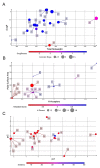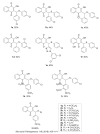Optimization of 1,4-Naphthoquinone Hit Compound: A Computational, Phenotypic, and In Vivo Screening against Trypanosoma cruzi
- PMID: 33467422
- PMCID: PMC7829778
- DOI: 10.3390/molecules26020423
Optimization of 1,4-Naphthoquinone Hit Compound: A Computational, Phenotypic, and In Vivo Screening against Trypanosoma cruzi
Abstract
Chagas disease (CD) still represents a serious public health problem in Latin America, even after more than 100 years of its discovery. Clinical treatments (nifurtimox and benznidazole) are considered inadequate, especially because of undesirable side effects and low efficacy in the chronic stages of the disease, highlighting the urgency for discovering new effective and safe drugs. A small library of compounds (1a-i and 2a-j) was designed based on the structural optimization of a Hit compound derived from 1,4-naphthoquinones (C2) previously identified. The biological activity, structure-activity relationship (SAR), and the in silico physicochemical profiles of the naphthoquinone derivatives were analyzed. Most modifications resulted in increased trypanocidal activity but some substitutions also increased toxicity. The data reinforce the importance of the chlorine atom in the thiophenol benzene ring for trypanocidal activity, highlighting 1g, which exhibit a drug-likeness profile, as a promising compound against Trypanosoma cruzi. SAR analysis also revealed 1g as cliff generator in the structure-activity similarity map (SAS maps). However, compounds C2 and 1g were unable to reduce parasite load, and did not prevent mouse mortality in T. cruzi acute infection. Phenotypic screening and computational analysis have provided relevant information to advance the optimization and design of new 1,4-naphthoquinone derivatives with a better pharmacological profile.
Keywords: Trypanosoma cruzi; chemotherapy; compound optimization; naphthoquinones; trypanocidal activity.
Conflict of interest statement
The authors declare no conflict of interest.
Figures




Similar articles
-
Efficacy of 2-hydroxy-3-phenylsulfanylmethyl-[1,4]-naphthoquinone derivatives against different Trypanosoma cruzi discrete type units: Identification of a promising hit compound.Eur J Med Chem. 2018 Jan 20;144:572-581. doi: 10.1016/j.ejmech.2017.12.052. Epub 2017 Dec 16. Eur J Med Chem. 2018. PMID: 29289882
-
In vitro and In vivo Biological Activity of Two Aryloxy-naphthoquinones in Mice Infected with Trypanosoma cruzi Strains.Med Chem. 2024;20(10):938-943. doi: 10.2174/0115734064287956240426110450. Med Chem. 2024. PMID: 38757318
-
Synthesis, structure-activity relationship and trypanocidal activity of pyrazole-imidazoline and new pyrazole-tetrahydropyrimidine hybrids as promising chemotherapeutic agents for Chagas disease.Eur J Med Chem. 2019 Nov 15;182:111610. doi: 10.1016/j.ejmech.2019.111610. Epub 2019 Aug 10. Eur J Med Chem. 2019. PMID: 31434040
-
Natural and synthetic naphthoquinones active against Trypanosoma cruzi: an initial step towards new drugs for Chagas disease.Curr Med Chem. 2011;18(1):144-61. doi: 10.2174/092986711793979779. Curr Med Chem. 2011. PMID: 21110810 Review.
-
Experimental models in Chagas disease: a review of the methodologies applied for screening compounds against Trypanosoma cruzi.Parasitol Res. 2018 Nov;117(11):3367-3380. doi: 10.1007/s00436-018-6084-3. Epub 2018 Sep 19. Parasitol Res. 2018. PMID: 30232605 Review.
Cited by
-
Natural-product-inspired design and synthesis of thiolated coenzyme Q analogs as promising agents against Gram-positive bacterial strains: insights into structure-activity relationship, activity profile, mode of action, and molecular docking.RSC Adv. 2022 Jul 15;12(32):20507-20518. doi: 10.1039/d2ra02136f. eCollection 2022 Jul 14. RSC Adv. 2022. PMID: 35919160 Free PMC article.
-
1,4-Naphthoquinone (CNN1) Induces Apoptosis through DNA Damage and Promotes Upregulation of H2AFX in Leukemia Multidrug Resistant Cell Line.Int J Mol Sci. 2022 Jul 23;23(15):8105. doi: 10.3390/ijms23158105. Int J Mol Sci. 2022. PMID: 35897681 Free PMC article.
-
Bioactivity of Novel Pyrazole-Thiazolines Scaffolds against Trypanosoma cruzi: Computational Approaches and 3D Spheroid Model on Drug Discovery for Chagas Disease.Pharmaceutics. 2022 May 5;14(5):995. doi: 10.3390/pharmaceutics14050995. Pharmaceutics. 2022. PMID: 35631581 Free PMC article.
References
-
- World Health Organization Targets and Milestones for Overcoming Neglected Tropical Diseases 2011–2020. [(accessed on 7 October 2020)]; Available online: https://www.who.int/chagas/strategy/en/
-
- Drug for Neglected Disease Initiative (DNDi), Paediatric Benznidazole. [(accessed on 7 October 2020)]; Available online: https://www.dndi.org/achievements/paediatric-benznidazole/
-
- Food and Drug Administration FDA Approves First U.S. Treatment for Chagas Disease. [(accessed on 7 October 2020)]; Available online: https://www.fda.gov/news-events/press-announcements/fda-approves-first-u....
-
- Hernández C., Salazar C., Brochero H., Teherán A., Buitrago L.S., Vera M., Soto H., Florez-Rivadeneira Z., Ardila S., Parra-Henao G., et al. Untangling the transmission dynamics of primary and secondary vectors of Trypanosoma cruzi in Colombia: Parasite infection, feeding sources and discrete typing units. Parasit. Vectors. 2016;9:620–632. doi: 10.1186/s13071-016-1907-5. - DOI - PMC - PubMed
-
- Noya B.A., Pérez-Chacón G., Díaz-Bello Z., Dickson S., Muñoz-Calderón A., Hernández C., Pérez Y., Mauriello L., Moronta E. Description of an oral Chagas disease outbreak in Venezuela, including a vertically transmitted case. Mem. Inst. Oswaldo Cruz. 2017;112:569–571. doi: 10.1590/0074-02760170009. - DOI - PMC - PubMed
MeSH terms
Substances
Grants and funding
LinkOut - more resources
Full Text Sources
Other Literature Sources
Medical
Miscellaneous

